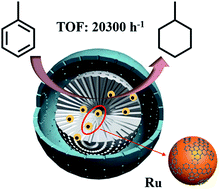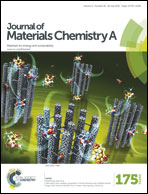Enhancing the catalytic activity of Ru NPs deposited with carbon species in yolk–shell nanostructures†
Abstract
The synthesis of metal NPs with a well-defined size, shape and composition provides opportunities for tuning the catalytic performance of metal NPs. However, the presence of a stabilizer on the metal surface always blocks the active sites of metal NPs. Herein, we report an efficient method to remove the stabilizer on the metal surface via H2 pyrolysis with Ru–poly(amindoamine) encapsulated in silica-based yolk–shell nanostructures as an example. The CO uptake amount of Ru NPs increases sharply after H2 pyrolysis, indicating that the exposure degree of Ru NPs is increased. No aggregation of the colloidal Ru NPs occurs after H2 pyrolysis, which could be mainly assigned to the protection effect of C and N species formed on Ru NPs. The overall activity of Ru NPs in the yolk–shell nanostructure after the pyrolysis could reach as high as 20 300 mmol per mmol Ru per h in the hydrogenation of toluene, which is much higher than that of most reported Ru-based solid catalysts. It was found that the yolk–shell nanostructure could efficiently prevent the leaching of Ru NPs during the catalytic process. Ru NPs in the yolk–shell nanostructure could also catalyze the hydrogenation of benzoic acid and Levulinic acid with high activity and selectivity.


 Please wait while we load your content...
Please wait while we load your content...